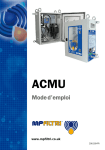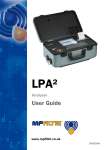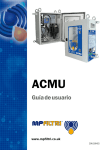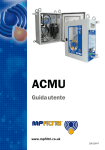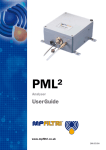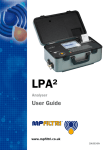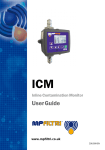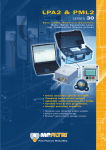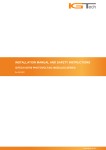Download ACMU/User Guide
Transcript
ACMU User Guide www.mpfiltri.co.uk 200.189-EN Safety Warning Hydraulic systems contain dangerous fluids at high pressures and temperatures. Installation, servicing and adjustment is only to be performed by qualified personnel. To secure optimum efficiency from your ACMU, we recommend that you read and follow the instructions set out in this manual. Do not tamper with this device. Should you have any questions please contact MP Filtri UK. Document Revision 1.1 Contents 1 Introduction 5 2 Variants 7 •Product Map "C-Version" •Installation dimensions "C-version" •Product Map "P-Version" •Installation dimensions "P-version" 3 Materials of Construction 12 4 Operating Procedures 13 •Mounting/Fixing •Hydraulics •Motor Wiring •Communication wiring "C-version" •Communication wiring "P-version" 5 Safety precautions 20 6 Fault Finding 21 A Measuring Water in Hydraulic and Lubricating Fluids 23 B ISO4406:1999 Cleanliness Code System 25 C NAS1638 Cleanliness Code System 27 D SAE AS4059 REV.E Cleanliness E Classification For Hydraulic Fluids 28 Recommendations 31 F Hydraulic System Target Cleanliness Levels G New ISO Medium Test Dust and its effect on ISO Contamination Control Standards 33 35 •Calibration •New Test Dust Benefits •Effect on Industry •Correlation •Other Standards H Clean working practises 42 1 Introduction MP Filtri UK’s ACMU combines technology to enable sampling on low pressure hydraulic and lubrication systems where aeration can be an issue. The ACMU suppresses the air bubbles so they are no longer counted as particles. The ACMU can be installed in most low pressure hydraulic and lubrication systems ranging from zero bar pressure to a maximum of 50 bar1 (D version pump). A further option (B version pump) can be installed on systems with a maximum of 6 bar on the inlet of ACMU pump and a maximum of 3 bar on system return. These two options give the user the versatility to install the ACMU in a variety of different system applications. Utilising the best contamination monitor product in its class as standard, the ACMU delivers the simplicity, practicality and accuracy for the most demanding of applications. Proven optical technology and algorithms, ensure consistent monitoring of your system, providing peace of mind for your operators/ investors. Both variants of ACMU come with an ICM as standard complete with RS485/232, MODBUS and CANBUS (J1939 typical) protocols for remote control. ICM communication and motor power needs to be completed by the customer during installation. Cable for motor is not supplied. 1 Designed with you in mind... The ACMU is configured deliberately to provide customers the versatility they require for existing systems or those in development. 1 All pressures are stated as gauge pressures in bar. Introduction 5 The in-built motor/pump assembly and automatic monitoring product (ICM) can be wired directly, allowing control through a wide range of communication protocol and logic controllers. A small footprint and lifting eyes make it the ideal solution for safe installation on new or retrofit applications. A wide range of operating voltages allow us to support a global market, and emerging technologies. 6 Introduction 2 Variants The ACMU comes ready assembled. It consists of a hydraulic gear pump fitted to an electric motor by means of a flexible coupling and bell housing. The pump/ motor is bolted to a frame assembly in one of the two variants described. 2.1 Product Map "C-Version" The "C-version" represents the functionality required in the more challenging of applications. The steel cabinet with integral lifting eyes provides protection and practicality during installation. • Multi-language instructions and smart phone interaction via product markings make installation simple for operators, especially in remote locations. • In-built USBi communication box means that diagnostic and ICM set up can be achieved via a laptop. • Supplied with a 5 metre 8 core shielded cable and instructions for ICM communications and power. Variants 7 Figure 1 8 Product map "C-version" Variants 2.2 Installation dimensions "C-version" Figure 2 Dimensions for "C-version" 2.3 Product Map "P-Version" Similar to the cabinet product, the "P-version" does not benefit from the same level of protection, interaction and USBi functionality. It is however... • • • Lighter weighing only 13kg More compact Supplied with a 3 metre 8 core shielded cable and instructions for ICM communications and power. Variants 9 Figure 3 10 Product map for "P-version" Variants 2.4 Installation dimensions "P-version" Figure 4 Variants Dimensions for "P-version" 11 3 Materials of Construction Wetted parts for both C and P units: − Brass − Stainless Steel − Aluminium "C-version" case: − Polyvinyl paint − Steel − Polyester 12 Materials of Construction 4 Operating Procedures 4.1 Mounting/Fixing Ensure that installation, servicing and adjustment is only performed by qualified personnel. − Install with the ICM in the vertical position. − Mount the ACMU using the mounting lugs provided. − Make sure the pressure gauge is visible at all times. − Enable access to all monitoring points. − Protect the ACMU against corrosion or aggressive environments if necessary. 4.2 Hydraulics − The inlet of the ACMU is the suction side of the pump, it is a 1/4"BSP inlet (also supplied with 1/4BSP to 7/16th JIC adaptor). − Connect the suction side of the pump to the reservoir by means of a hydraulic hose, use the correct internal diameter e.g. 1/4". − Keep the suction hose as short as possible, make sure the pressure never drops below atmospheric. Operating Procedures 13 − Connect the suction line to the lowest point of the reservoir, e.g. the drain. If this is not possible find a suitable location or use a down pipe through the filter lid. − The point of suction must be below the fluid level. − Use correct hydraulic fittings and hydraulic hoses for the installation. − Do not use Teflon tape or liquid sealants. − Do not fit ball valve or any other obstructions in the return line of the filter unit, the return line must be free to flow back to tank. − Keep the return line as short as possible and use hydraulic hose of the correct internal diameter e.g. 1/4". − Make sure the point of return on the reservoir is as far away as possible from suction point. 4.3 Motor Wiring Ensure that a qualified electrician carry out the electric installation of the ACMU. − Before installation, ensure that the electrical data of the electric motor corresponds with the data of the local electrical supply. − Connection 3 phase/ 1 phase − Ensure that the electric motor rotates in accordance with the arrow on the electric motor. 14 Operating Procedures Wiring Diagram for Electric Motor Description Visual 3 Phase motor Not connected Υ -star Δ -triangle Operating Procedures 15 Description Visual 1 Phase motor Not connected Left rotation Right rotation Technical Details E-motors 3 phase 50Hz 16 Description Voltage Δ/Υ Nominal Current RPM Setting mot. protection 0.18kW 230/400 VAC 1.03 A/ 0.60 A 1345 Nominal Current 0.18kW 200/400 VAC 1.03 A/ 0.60 A 1345 Nominal Current 0.29kW 230/400 VAC 1.65 A/ 0.95 A 1320 Nominal Current 0.37kW 230/400 VAC 1.90 A/ 1.10 A 1350 Nominal Current 0.37kW 200/346 VAC 2.10 A/ 1.19 A 1350 Nominal Current 0.60kW 230/400 VAC 2.75 A/ 1.60 A 1350 Nominal Current Operating Procedures 3 phase 60Hz Description Voltage Δ/Υ Nominal Current RPM Setting mot. protection 0.21kW 265/460 VAC 1.04 A/ 0.60 A 1650 Nominal Current 0.18kW 200/340 VAC 1.06 A/ 0.62 A 1575 Nominal Current 0.33kW 265/460 VAC 1.65 A/ 0.95 A 1585 Nominal Current 0.37kW 200/346 VAC 1.85 A/ 1.08 A 1630 Nominal Current 0.43kW 265/460 VAC 1.85 A/ 1.10 A 1655 Nominal Current 0.69kW 265/460 VAC 2.63 A/ 1.52 A 1655 Nominal Current 1 phase 50Hz Description Voltage Nominal Current RPM Setting mot. protection 0.18kW 110 VAC 3.30 A 1415 Nominal Current 0.18kW 230 VAC 1.30 A 1415 Nominal Current 0.37kW 110 VAC 6.10 A 1400 Nominal Current 0.37kW 230 VAC 2.90 A 1400 Nominal Current Description Voltage Nominal Current RPM Setting mot. protection 0.18kW 110 VAC 2.70 A 1710 Nominal Current 0.18kW 230 VAC 1.30 A 1710 Nominal Current 0.37kW 110 VAC 5.20 A 1700 Nominal Current 0.37kW 230 VAC 2.50 A 1700 Nominal Current 1 phase 60Hz Operating Procedures 17 4.4 Communication wiring "C-version" Figure 1 Wiring diagram for "C-version" For further information on communications and wiring please refer to the supplied CD containing relevant user guides. 18 Operating Procedures 4.5 Communication wiring "P-version" Figure 2 Wiring diagram for "P-version" Operating Procedures 19 5 Safety precautions 1 Dangers The ACMU is designed to comply with the latest technological and safety standards. Nevertheless, its incorrect usage can present danger to the user or third party. The ACMU must only be used − in line with guidance from MP Filtri UK. − when in perfect working order with regard to safety regulations. Faults which could affect safety must be rectified immediately. In addition to the installation manual, the general and local regulations concerning accident prevention and environment (and conservation respectively) must be observed and followed. All safety installations must be in place and fully functional before starting up the system. Check from time to time if there are exterior damages and if the ACMU works correctly. Do not carry out any alterations, conversions or additions to the ACMU without the written consent of MP Filtri UK. Defective parts have to be replaced immediately by original spare parts. If other parts are used there is no guarantee they are suitable for the use and built to applicable safety standards. We recommend to run the ACMU with mineral oil in accordance with DIN 51524, 51525. Do not operate with other fluids without the consent of MP Filtri UK. 2 Dangers by electricity All work on the electrical equipment of the ACMU must be carried out by a qualified electrician. Check the electrical equipment of the ACMU regularly. Rectify any faults immediately. 20 Safety precautions 6 Fault Finding FAULT CHECK No oil flow Check rotation of electric motor, if incorrect change the electrical connection. Pump is not drawing fluid, pre-fill the suction hose with oil and start again. Electric motor keeps tripping Fault Finding Check local grid with motor identification plate. Check motor protection switch for setting and adjust according to electric motor identification label. Adjust to normal Amperage +10%. 21 Airlock at start up Vent the system. Open the measuring point or the valve shown in the figure below. Make sure the suction hose is filled with oil before start up. The return line must be connected to the application reservoir (pressure-less). To set the system pressure, provide the manifold with a pressure gauge and adjust the valve shown in the figure below. 22 Fault Finding Appendix A Measuring Water in Hydraulic and Lubricating Fluids From North Notts Fluid Power Centre In mineral oils and non aqueous fire resistant fluids water is undesirable. Mineral oil usually has a water content of 50-300 ppm which it can support without adverse consequences. Once the water content exceeds about 500ppm the oil starts to appear hazy. Above this level there is a danger of free water accumulating in the system in areas of low flow. This can lead to corrosion and accelerated wear. Similarly, fire resistant fluids have a natural water content which may be different to mineral oils. Saturation Levels Since the effects of free (also emulsified) water is more harmful than those of dissolved water, water levels should remain well below the saturation point. However, even water in solution can cause damage and therefore every reasonable effort should be made to keep saturation levels as low as possible. There is no such thing as too little water. As a guideline, we recommend maintaining saturation levels below 50% in all equipment. Measuring Water Content 23 Appendix A Typical Water Saturation Levels For New Oils Figure I Examples: 24 Hydraulic oil @ 30°C = 200ppm = 100% saturation Hydraulic oil @ 65°C = 500ppm = 100% saturation Measuring Water Content Appendix B ISO4406:1999 Cleanliness Code System The International Standards Organization standard ISO 4406:1999 is the preferred method of quoting the number of solid contaminant particles in a sample. The code is constructed from the combination of three scale numbers selected from the following table. The first scale number represents the number of particles in a millilitre sample of the fluid that are larger than 4 µm(c). The second number represents the number of particles larger than 6 µm(c). The third represents the number of particles that are larger than 14 µm(c). ISO4406:1999 Cleanliness Code System 25 Appendix B Microscope counting examines the particles differently to APCs and the code is given with two scale numbers only. These are at 5 µm and 15 µm equivalent to the 6 µm(c) and 14 µm(c) of the APCs. 26 ISO4406:1999 Cleanliness Code System Appendix C NAS1638 Cleanliness Code System The NAS system was originally developed in 1964 to define contamination classes for the contamination contained within aircraft components. The application of this standard was extended to industrial hydraulic systems simply because nothing else existed at the time. The coding system defines the maximum numbers permitted of 100ml volume at various size intervals (differential counts) rather than using cumulative counts as in ISO 4406:1999. Although there is no guidance given in the standard on how to quote the levels, most industrial users quote a single code which is the highest recorded in all sizes and this convention is used on the ACMU software. Figure I CONTAMINATION LEVEL CLASSES according to NAS1638 (January 1964). The contamination classes are defined by a number (from 00 to 12) which indicates the maximum number of particles per 100 ml, counted on a differential basis, in a given size bracket. NAS1638 Cleanliness Code System 27 Appendix D SAE AS4059 REV.E Cleanliness Classification For Hydraulic FluidsII This SAE Aerospace Standard (AS) defines cleanliness levels for particulate contamination of hydraulic fluids and includes methods of reporting data relating to the contamination levels. Tables 1 and 2 below provide the Maximum Contamination Limits (Particles/100ml) of differential and cumulative particle counts respectively for counts obtained by an automatic particle counter, e.g. ACMU. II The information reproduced on this and the previous page is a brief extract from SAE AS4059 Rev.E, revised in May 2005. For further details and explanations refer to the full Standard. 28 SAE AS4059 REV.E Cleanliness Classification For Hydraulic . . . Appendix D Size range μm(c): 6 - 14 14 - 21 21 - 38 00 125 22 0 250 44 1 500 89 2 1,000 178 3 2,000 356 4 4,000 712 5 8,000 1,425 6 16,000 2,850 7 32,000 5.700 8 64,000 11,400 9 128,000 22,800 10 256,000 45,600 11 512,000 91,200 12 1,024,000 182,400 4 8 16 32 63 126 253 506 1,012 2,025 4,050 8,100 16,200 32,400 38 - 70 >70 Class Table I 1 0 2 0 3 1 6 1 11 2 22 4 45 8 90 16 180 32 360 64 720 128 1,440 256 2,880 512 5,760 1,024 AS4059E Table 1 - Cleanliness Classes for Differential Parti- cle Counts SAE AS4059 REV.E Cleanliness Classification For Hydraulic . . . 29 Appendix D Size μm(c) >4 >6 >14 >21 >38 >70 Size Code A B C D E F 195 390 780 1,560 3,120 6,250 12,500 25,000 50,000 100,000 200,000 400,000 800,000 1,600,000 3,200,000 76 152 304 609 1,217 2,432 4,864 9,731 19,462 38,924 77,849 155,698 311,396 622,792 1,245,584 14 27 54 109 217 432 864 1,731 3,462 6,924 13,849 27,698 55,396 110,792 221,584 Classes 000 00 0 1 2 3 4 5 6 7 8 9 10 11 12 3 1 0 5 1 0 10 2 0 20 4 1 39 7 1 76 13 2 152 26 4 306 53 8 612 106 16 1,224 212 32 2,449 424 64 4,898 848 128 9,796 1,696 256 19,592 3,392 512 39,184 6,784 1,024 Table II AS4059E Table 2 - Cleanliness Classes for Cumulative Particle Counts 30 SAE AS4059 REV.E Cleanliness Classification For Hydraulic . . . Appendix E Recommendations Unit Type ISO 4406:1999 Code PUMP Piston (slow speed, in-line) Piston (high speed, variable) Gear Vane 22/20/16 17/15/13 19/17/15 18/16/14 MOTOR Axial piston Radial piston Gear Vane 18/16/13 19/17/13 20/18/15 19/17/14 VALVE Directional (solenoid) 20/18/15 Pressure control (modulating) 19/17/14 Flow control 19/17/14 Check valve 20/18/15 Cartridge valve 20/18/15 Proportional 18/16/13 Servo-valve 16/14/11 ACTUATOR 20/18/15 Table I Typical Manufacturers Recommendations for Component Cleanliness (ISO 4406:1999)III Most component manufacturers know the proportionate effect that increased dirt level has on the performance of their components and issue maximum permissible contamination levels. They state that operating components on III It should be noted that the recommendations made in this table should be viewed as starting levels and may have to be modified in light of operational experiences or user requirements. Recommendations 31 Appendix E fluids which are cleaner than those stated will increase life. However, the diversity of hydraulic systems in terms of pressure, duty cycles, environments, lubrication required, contaminant types, etc, makes it almost impossible to predict the components service life over and above that which can be reasonably expected. Furthermore, without the benefits of significant research material and the existence of standard contaminant sensitivity tests, manufacturers who publish recommendations that are cleaner than competitors may be viewed as having a more sensitive product. Hence there may be a possible source of conflicting information when comparing cleanliness levels recommended from different sources. The table gives a selection of maximum contamination levels that are typically issued by component manufacturers. These relate to the use of the correct viscosity mineral fluid. An even cleaner level may be needed if the operation is severe, such as high frequency fluctuations in loading, high temperature or high failure risk. 32 Recommendations Appendix F Hydraulic System Target Cleanliness Levels Where a hydraulic system user has been able to check cleanliness levels over a considerable period, the acceptability, or otherwise, of those levels can be verified. Thus if no failures have occurred, the average level measured may well be one which could be made a bench mark. However, such a level may have to be modified if the conditions change, or if specific contaminant-sensitive components are added to the system. The demand for greater reliability may also necessitate an improved cleanliness level. The level of acceptability depends on three features: − the contamination sensitivity of the components − the operational conditions of the system − the required reliability and life expectancy Hydraulic System Target Cleanliness Levels 33 Appendix F Contamination Corresponding Recommended Typical Codes Codes Filtration Applications ISO 4406:1999 NAS 1638 Degree 4 6 14 Bx200 μm(c) μm(c) μm(c) 14 12 9 3 3 17 15 11 6 3-6 18 16 13 7 10-12 Very sensitive - high reliability systems 20 18 14 9 12-15 Sensitive - reliable systems 21 19 16 10 15-25 General equipment of limited reliability 23 21 18 12 25-40 Low - pressure equipment not in continuous service High precision and laboratory servo-systems Robotic and servo-systems The table above is a guide to the recommended filtration level for various hydraulic components, together with typical target system cleanliness levels. 34 Hydraulic System Target Cleanliness Levels Appendix G New ISO Medium Test Dust and its effect on ISO Contamination Control Standards When General Motors gave advance warning to the International Standards Organization (ISO) that it was intending to stop the production of AC Fine Test Dust (ACFTD), work commenced immediately on finding an improved replacement dust. ACFTD was used extensively within the fluid power and automotive industries for calibrating Automatic Particle Counters (APCs) and for the testing of components. APCs are used for testing oil filters, and also for contaminant sensitivity testing of hydraulic components. For 25 years, APCs have been the main stay in the measurement of solid particles in hydraulic fluids. The growth in demand for measuring fluid cleanliness in a variety of industrial processes, including fluid power, has resulted in APCs moving from the laboratory environment out into the factory. In fact, they are now a critical part of many production processes. It is therefore essential that the data they provide is both accurate and consistent. Calibration ACFTD has been used as an artificial contaminant since the 1960s and its original particle size distribution was determined using an optical microscope. This particle size distribution subsequently formed the basis of ISO 4402, the method for calibrating APCs. Due to the limitations of that method of measurement, the particle size distribution was questioned below about 5µm. It was also not traceable to any national standard of measurement - a critical requirement for today’s quality management systems. There was also an absence of formal controls over the distribution of the test dust, and batch-to-batch variability was much greater than is acceptable nowadays. New ISO Medium Test Dust and its effect on ISO . . . 35 Appendix G ISO therefore defined the requirements for the replacement for ACFTD and asked the National Institute of Standards and Technology (NIST) in the USA to produce a standard, traceable reference material. The new dust’s particle size distribution has been accurately determined with the aid of modern scanning electron microscope and image analysis techniques. New Test Dust Benefits The new ISO Medium Test Dust (ISO MTD) consists of similar materials to the old ACFTD, but to minimize particle counting errors, it is of a slightly coarser grade because ACFTD included too many particles smaller than 5µm which gave problems during testing. ISO MTD is produced to a standard distribution and stringent quality control procedures, thereby ensuring excellent batch-to-batch repeatability. These procedures, combined with a revised ISO APC calibration method give: − A traceable and controlled reference test dust with greatly reduced variation in particle size distribution. This gives the trace-ability required by ISO 9000, QS9000 and similar quality management systems. − A procedure for determining the performance of APCs so that minimum acceptable levels can be set by the user. − Improved calibration techniques and procedures. − More accurate calibration. − Improved levels of particle count reproducibility with different equipment. − More accurate and consistent filter test results. Effect on Industry The introduction of ISO MTD has necessitated changes to certain ISO standards. 36 New ISO Medium Test Dust and its effect on ISO . . . Appendix G The standards affected include: ISO 4402:1991 Hydraulic fluid power Calibration of liquid automatic particle counters. ISO 4406:1987 Hydraulic fluid power Code for defining the level of contamination by solid particles. ISO 4572:1981 Hydraulic fluid power – Filters Multi-pass method for evaluating filtration performance of a filter element. In order that users are not confused by the changes to these standards, particularly by reference to them in technical literature, ISO is updating 4402 to ISO 11171, and 4572 to ISO 16889. Two standards which concern our industry are the ISO 4406 coding system and the new ISO 16889 Multi-pass test. As APCs will henceforth count particles more accurately, there will now be a change in the way sizes are labelled. In the new ISO 4406:1999, new calibration sizes are used to give the same cleanliness codes as the ‘old’ calibration sizes of 5 and 15 µm. In this way, there will be no necessity to change any system cleanliness specifications. It is proposed that the cleanliness codes (for APCs) will be formed from threeIV particle counts at 4, 6 and 14 µm, with 6 and 14 µm corresponding very closely to the previous 5 and 15 µm measurements. This will ensure consistency in data reporting. As the counts derived by microscope counting methods are not affected, the particle sizes used for microscopy will remain unchanged (i.e. at 5 and 15 µm). IV The option of quoting just two counts of 6µm and 14µm for APCs remains. New ISO Medium Test Dust and its effect on ISO . . . 37 Appendix G To clarify matters still further, ISO standards written around the new test dust will utilize a new identifier, ‘(c)’. Hence µm sizes according to the new ISO 11171 will be expresses as ‘µm(c)’ and Beta ratios according to ISO 16889 will be expressed as ‘Bx(c)’, e.g.‘B5(c)’. However, it must be stressed that the only real effect users will experience will be the improved accuracy in particle counts - there will be no change in the performance of filters, nor in the ISO cleanliness levels that they will achieve. The following charts shows the correlation between the old ACFTD and the new ISO MTD. The ACMU is calibrated with ISO Medium Test Dust (to ISO 11171). The correlation between particle sizes and the ACFTD (old standard) to the ISO MTD (new standard) is as follows : ACFTD ISO MTD V VI <1 5 15 25 30 50 75 4 6 14 21 25 38 50V 100 70VI Not verified by NIST acftd 38 New ISO Medium Test Dust and its effect on ISO . . . Appendix G Correlation The table shows the correlation between Particle Sizes Obtained using ACFTD (ISO 4402:1991) and NIST (ISO 11171) Calibration Methods This table is only a guideline. The exact relationship between ACFTD sizes and the NIST sizes may vary from instrument to instrument depending on the characteristics of the particle counter and original ACFTD calibration. Particle Size Obtained Using ACFTD ISO/NIST MTD (ISO (ISO 11171) 4402:1991) µm µm(c) 1 4.2 2 4.6 3 5.1 4 5.8 5 6.4 6 7.1 7 7.7 8 8.4 9 9.1 10 9.8 11 10.6 12 11.3 13 12.1 14 12.9 15 13.6 16 14.4 17 15.2 18 15.9 19 16.7 20 17.5 21 18.2 22 19.0 23 19.7 24 20.5 25 21.2 26 22.0 27 22.7 28 23.5 29 24.2 30 24.9 31 25.7 32 26.4 33 27.1 34 27.9 35 28.5 36 29.2 37 29.9 38 30.5 39 31.1 40 31.7 New ISO Medium Test Dust and its effect on ISO . . . 39 Appendix G Other Standards Although the ISO 4406:1999 standard is being used extensively within the hydraulics industry other standards are occasionally required and a comparison may be requested. The following table gives a very general comparison but often no direct comparison is possible due to the different classes and sizes involved. VII All section headings indicated with [] are reproduced by kind permission of British Fluid Power Association from BFPA/P5 1999 issue 3 Appendix 44 40 New ISO Medium Test Dust and its effect on ISO . . . Appendix G ISO 4406:1999 13/11/08 14/12/09 15/13/10 16/14/09 16/14/11 17/15/09 17/15/10 17/15/12 18/16/10 18/16/11 18/16/13 19/17/11 19/17/14 20/18/12 20/18/13 20/18/15 21/19/13 21/19/16 22/20/13 22/20/17 23/12/14 23/21/18 24/22/15 25/23/17 DEF.STD 05/42 [7]VII NAS 1638[5] Table A ISO 11218[6] Table B SAE 749[8] 2 3 4 0 1 5 2 6 3 7 4 8 5 9 6 400F 400 800F 800 1,300F 1,300 2000F 2,000 4,400F 4,400 6,300F 10 6,300 11 15,000 12 21,000 100,000 Table I New ISO Medium Test Dust and its effect on ISO . . . 41 Appendix H Clean working practises The majority of hydraulic systems require cleanliness which controls below around a 40 micron threshold (beyond the limit of human eyesight). When analysing particles down to levels of 4um, 6um & 14um you are talking about objects of a cellular/bacterial size. This creates various challenges, and is starting to drive better and cleaner working practices in industry. Our products are at the forefront of this challenge, and will help you to manage the quality and productivity of your systems. Do’s − Do use filter breathers on tank tops. − Do use tank designs, which are self draining (sloped or conical). − Do use tanks which can be sealed off from the surrounding environment. − Do exercise care and use funnels when filling tanks with fluid. − Do utilize stainless steel and methods such as electro-polishing in the design of system components upstream of your first filter set. − Do perform off-line analysis in a controlled environment such as a laboratory which should contain fewer airborne contaminants that where the sample was taken from. − Do use suitable, glass bottles (ideally certified clean) to take samples, along with a hand pump to reduce contamination ingress. − Do filter your system thoroughly before using it in your production process. 42 Clean working practises Appendix H − Do perform a statistically large enough sample of particle analysis results ( 25) to arrive at a base cleanliness level for your system. − Do make sure that filters are correctly sized for your applications and cleanliness you are trying to achieve. Don’ts − Don’t eat, drink or smoke around critical systems/processes. − Don’t leave tools, objects, clothing or other materials etc. on surfaces or tanks of critical systems. − Don’t use open tanks on critical systems. − Don’t take samples or perform on-line analysis from the top of a reservoir/tank. − Don’t design/use tanks which contain crevices (internal corners etc). − Don’t assume that if a sample looks clean, that it is. You wont be able to see the contaminants. − Don’t perform off-line analysis in an “un-controlled” environment. E.g. workshop. − Don’t rely on a single test for a capable representation of your system. − Don’t start using your system/process until it has gone through a commissioning period whereby contamination levels are relatively stable. − Don’t mix fluids into the same system. They can emulsify and eliminate any chance of a reliable particle count. − Don’t use unsuitable containers to take a fluid sample. Clean working practises 43 Appendix H 44 Clean working practises 1 Warranty & Servicing MP Filtri UK warrants that the products that it manufactures and sells will be free from defects in material, workmanship & performance for a period of 12 months from the date of shipment. 2 Hardware/Firmware Should the hardware prove defective during the warranty period, MP Filtri UK, at its discretion, will either repair the defective product or replace it with an equivalent product in exchange for the defective unit without charge for parts, labour, carriage and insurance. 3 Software MP Filtri UK warrants that software will operate substantially in accordance with its functional specification for 12 months from date of shipment provided that the integrity of the operating environment has not been compromised through misuse, inappropriate handling, abnormal operating conditions, neglect or damage (unintentional or otherwise) or the introduction of third party product (software or hardware) that in any way conflicts with the MP Filtri UK product. 4 Eligibility This warranty extends to the original purchaser only or to the end-user client of a MP Filtri UK authorised affiliate. 5 How to obtain service? To obtain service under the terms of this warranty, the customer is required to notify MP Filtri UK before the expiration of the warranty period and to return 45 the item in accordance with MP Filtri UK product return policy. Any product returned for warranty repair must be accompanied by a full fault report specifying the symptoms and the conditions under which the fault occurs. Should MP Filtri UK incur additional cost as a result of a failure to complete the appropriate paperwork, an administrative charge may be levied. 6 Exclusions This warranty shall not apply to any defect, failure or damage caused by improper use or improper or inadequate care. MP Filtri UK shall not be obligated to provide service under this warranty if: − Damage has been caused by a failure to make a full and proper inspection of the product (as described by the documentation enclosed with the product at the time of shipment) on initial receipt of the product following shipment; − Damage has been caused by the attempts of individuals, other than MP Filtri UK staff to repair or service the product; − Damage has been caused by the improper use or a connection with incompatible equipment or product including software applications. 7 Charges Under cover of this warranty, MP Filtri UK will pay the carriage and insurance charges for the shipment of defective product back to MP Filtri UK and for its return to the client’s original site of despatch except when: − MP Filtri UK product return policy has not been followed. 46 − Product failure is caused by any of the exclusions described above, when the customer will be liable for the full cost of the repair (parts and labour) plus all carriage and insurance costs to and from MP Filtri UK premises. − The product is damaged in transit and a contributory cause is inadequate packaging. It is the customer’s responsibility to ensure that the packaging used to return equipment to MP Filtri UK is the same, or has equivalent protective qualities, to that used to ship the product to the customer in the first instance. Any damage resulting from the use of inadequate packaging will nullify MP Filtri UK obligations under this warranty. Should the customer’s product be damaged in transit following a repair at MP Filtri UK site, a full photographic record of the damage must be obtained (packaging and the product) to support any claim for recompense. Failure to present this evidence may limit MP Filtri UK obligations under this warranty. THIS WARRANTY IS GIVEN BY MP Filtri UK IN LIEU OF ANY OTHER WARRANTIES, EXPRESS OR IMPLIED, INCLUDING BUT NOT LIMITED TO ANY IMPLIED WARRANTY OF MERCHANTABILITY, NON INFRINGEMENT OR FITNESS FOR A PARTICULAR PURPOSE. MP Filtri UK LTD SHALL NOT BE LIABLE FOR ANY SPECIAL, INDIRECT, INCIDENTAL OR CONSEQUENTIAL DAMAGES OR LOSSES, INCLUDING LOSS OF DATA. WE SPECIFICALLY DISCLAIM ANY AND ALL WARRANTIES TO CUSTOMERS OF THE CUSTOMER. THE CUSTOMER’S SOLE REMEDY FOR ANY BREACH OF WARRANTY IS THE REPAIR OR REPLACEMENT, AT MP FILTRI DISCRETION, OF THE FAILED PRODUCT. MP Filtri UK maintains a policy of product improvement and reserves the right to modify the specifications without prior notice. 47 48 Produced by MP Filtri UK Revision 1.1 As a policy of continual improvement, MP Filtri UK reserve the right to alter specifications without prior notice. Except as permitted by such licence, no part of this publication may be reproduced, stored in retrieval system or transmitted, in any form or any means, electronic, mechanical, recording, or otherwise, without prior written permission of MP Filtri UK. MP FILTRI UK Limited, Bourton Industrial Park, Bourton-on-the-Water, GL54 2HQ, U.K. Tel: +44.1451-822522 Fax: +44.1451-822282 Email: [email protected] Website: www.mpfiltri.co.uk www.mpfiltri.co.uk ITALY - HEADQUARTERS MP FILTRI S.p.A. Tel: +39.02/95703.1 Fax: +39.02/95741497-95740188 Email: [email protected] Website: www.mpfiltri.com FRANCE MP FILTRI FRANCE Tel: +33.1.40-86-47-00 Fax: +33.1-40-86-47-09 Email: [email protected] Website: www.mpfiltri.com CANADA MP FILTRI CANADA INC. Tel: +1.905-303-1369 Fax: +1.905-303-7256 Email: [email protected] Website: www.mpfiltricanada.com INDIA MP FILTRI INDIA Tel: +91 9945599899 Email: [email protected] Website: www.mpfiltri.com CHINA MP FILTRI (Shanghai) Co Ltd Tel: +86.21-58919916 Fax: + 86.21-58919667 Email: [email protected] Website: www.mpfiltrichina.com GERMANY MP FILTRI D GmbH Tel: +49.6894-95652-0 Fax: + 49.6894-95652-20 Email: [email protected] Website: www.mpfiltri.de RUSSIAN FEDERATION MP FILTRI RUSSIA INC Phone mobile: +7.095-502-5411 Fax: +7.095-205-9410 Email: [email protected] Website: www.mpfiltri.ru USA MP FILTRI USA Inc. Tel: +1.215-529-1300 Fax: +1.215-529-1902 Email: [email protected] Website: www.mpfiltriusa.com UAE MP FILTRI UEA Tel: +91 9945599899 Email: [email protected] Website: www.mpfiltri.com


















































